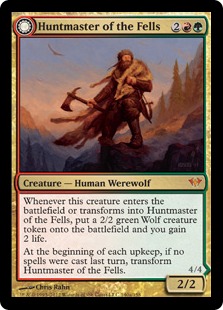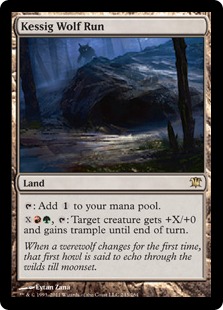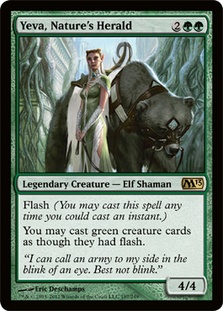Today I would like to talk about a deck I have been working on tuning and playing in Standard for a little over a month now: RUG Flash (or as my friends and I call it, the Magic Carpet). A couple of weeks before SCG Open Series: Indianapolis, I set out to find a deck that is both competitive and something that I enjoy playing. After much brewing, testing, and pouring over decklists, I found a deck that fits both of my criteria in the Magic Carpet.
I’ve played the Magic Carpet to two cash finishes in the past month: one at SCG Standard Open: Indianapolis (8-3, for 57th place out of 700+ people) and the other at SCG Standard Open: Kansas City (8-2, for 15th place out of 400+ people). The more I’ve played the list, the more I like it and the more I’ve been able to tune it to do what I want. The largest change I made to the deck between #SCGINDY and #SCGKC was the addition of Think Twice (not sure why I didn’t add this card sooner, but more on that in a bit). You can find the deck tech for the list I played in Kansas City here.
Before I talk about my card choices and how the list plays, I’d like to share where my list stands:
Creatures (15)
Lands (25)
Spells (20)
Sideboard

Playing the Deck
At its core, RUG Flash is a Huntmaster deck. Any time we get to untap with a Huntmaster of the Fells on the table, we are in a good place. Because this deck plays out almost entirely at instant speed, we are almost always able to pass our own turn without casting a spell, flipping Huntmaster into a Ravager. Then, between Think Twice and Snapcaster Mage, we almost always get to end our opponent’s turn by casting two spells, flipping our Ravager back into Huntmaster. So, in addition to a four-life swing in our favor almost every turn, we also gain the advantage of removing opposing creatures while simultaneously building our own board presence through the addition of a Wolf token.
Huntmaster is not the only creature in the list that generates card advantage for us though—virtually every one of our other creatures can do the same. Wolfir Avenger and Yeva, Nature’s Herald both come down at instant speed as surprise blockers versus aggro decks. Against control, Wolfir’s regeneration and Yeva’s four toughness make them threats that are hard to remove. Snapcaster, on the other hand, recasts one of our many spells while leaving behind a 2/1 body.
While we are waiting to stick one of our versatile threats, the Magic Carpet acts as a draw-go style control deck that aims to one for one the other player by removing their creatures with burn spells and stopping their scariest spells with countermagic. The most important thing to remember while doing this is that our life total is a resource; by this I mean that unless there is no other choice, we do not kill their creatures during combat to save three points of damage if it means we are giving them a chance to stick something frightening during their second main phase.
Finally, against aggressive decks like Naya Blitz, remember that Snapcaster has the “hidden” mode of simply being an Ambush Viper. So when they vomit their hand onto the table and we happen not to have any removal yet, feel free to end step (or mid-combat before blocks) Snappy if it means he will be saving us damage in the long run.
Specific Card Choices
1 Kessig Wolf Run
I’ve been asked many times why I only include one of this card; the answer is two-fold. First, many of the spells in this deck are very color intensive (Izzet Charm, Dissipate, Wolfir, Yeva) so having one of the first three land drops come down as a colorless source is often the difference between losing the game and winning it. Second, this is not a tap-out control deck, meaning I generally only feel safe tapping out for a Kessig activation when it is to close a game that same turn (also, tapping out for a Kessig activation and then having your creature get sent to the top of your deck by an Azorius Charm feels awful).
4 Yeva, Nature’s Herald
Yes, I am aware Yeva is legendary. I am also aware that having her on the table makes Huntmaster reach an insane power level. Beyond this, a 4/4 flash threat in a world filled with two- and three-power creatures that like to attack is fantastic. The problem is that she has a giant target on her head. Most decks with low-power creatures are also playing four copies of Searing Spear, meaning after she blocks something she often gets finished off by one of those. This means that once the other player has expended two cards to kill the first Yeva, I have the highest possible chance to immediately stick another Yeva the following turn.
0 Thragtusk
That’s right, folks—you can play a green midrange deck and not auto-include four Thragtusk. That being said, I actually played two Thragtusk in the Magic Carpet in Indianapolis and found them generally underwhelming. I rarely wanted to tap out for it on turn 5, and it was almost never better than Yeva or Huntmaster. Beyond this, the Magic Carpet already plays eight four-mana threats (eleven if we plan to be Snapping our spells back) so adding five-drops to the mix makes the list really top-heavy.
0 Simic Charm
This card looks amazing on paper, so much so in fact that the Magic Carpet started with three of them in the 75. By the time #SCGINDY came around, I only had a single copy left in the sideboard, and for #SCGKC I dropped the card altogether. It simply didn’t do enough to actively answer what the other decks are trying to do.
Matchups and Sideboarding
Naya Blitz
To say our countermagic is bad in this matchup is an understatement. In addition to them flooding the board very early, this deck generally plays the full four Cavern of Souls just to fix its mana base. Thankfully, the removal half of our deck is very powerful against them, meaning if we know what we are paired against and mulligan appropriately, our game 1 against Blitz can be fine.
That being said, I think this is a favorable matchup overall. In addition to our deck having far more consistent draws than they do, we get to board out all of our bad cards in games 2 and 3. Generally, sideboarding for this matchup looks like:
-3 Syncopate
-2 Dissipate
-1 Essence Scatter
+3 Pillar of Flame
+2 Magmaquake
+1 Augur of Bolas
Jund Aggro
This aggro matchup is even more favorable than Naya Blitz due to the fact that our countermagic works here. That being said, we still board out the Syncopates when we are on the draw. So on the draw, sideboarding looks like this:
-2 Syncopate
-2 Dissipate
-1 Think Twice
+3 Pillar of Flame
+2 Magmaquake
On the play, we like Syncopate because it can stop their turn 2 play. So we board like this:
-1 Dissipate
-1 Think Twice
Esper Control
This matchup in general can be favorable if we know which spells we need to fight over (hint: do not let a Sphinx’s Revelation resolve). Beyond that, Wolfir Avenger is an absolute house in this matchup. The fact that he regenerates makes him a very hard threat to deal with. On the flip side (pun intended), Huntmaster of the Fells often feels lackluster in this matchup due to the four Supreme Verdict Esper generally plays.
When we sideboard for this matchup, we do the following:
-4 Searing Spear
-1 Izzet Charm or Syncopate (Izzet Charm if they are playing Lingering Souls, Syncopate otherwise)
-1 Essence Scatter
+3 Garruk, Primal Hunter
+1 Dissipate
+2 Counterflux
Post-board it is important to remember that while we gained more powerful countermagic, so did they. It is critical to try to not run Garruk, Primal Hunters into their counterspells. They are our heavy hitter in this matchup, and if we ever get to untap with one on the table, generally we are going to win that game.
Jund
Other midrange decks that are not playing Cavern of Souls feel like good matchups—Jund included. Liliana of the Veil and Garruk, Primal Hunter are not particularly impressive versus our army of flash creatures, and their threat density is generally lower than our total number of answers (countermagic and removal). Plus, if they aren’t playing Tragic Slip, Wolfir Avenger is an eternal thorn in their side.
This is another matchup where we dislike Syncopate on the draw, so sideboarding looks like this:
-3 Izzet Charm
-1 Syncopate (-2 on the draw)
-1 Yeva, Nature’s Herald
+3 Garruk, Primal Hunter
+1 Dissipate
+1 Counterflux (+2 on the draw)
U/W/R Flash
This matchup can be a bit rough. In addition to having lots of removal, they also have Sphinx’s Revelation. This means we need to use our best judgment for when we should expend countermagic to protect our threats and when we need to hold it to stop a game-winning Sphinx’s Revelation. Also worth noting is that we need to board different versus the U/W/R lists playing Boros Reckoner and those that are not.
Against versions with Boros Reckoner:
-3 Izzet Charm
-1 Huntmaster of the Fells
-1 Syncopate
+2 Counterflux
+1 Dissipate
+2 Garruk, Primal Hunter
Against versions without Boros Reckoner:
-4 Searing Spear
-2 Izzet Charm
+2 Counterflux
+1 Dissipate
+3 Garruk, Primal Hunter
G/W/B Reanimator
Like most of the midrange decks in the format, this is the hardest of the matchups for the Magic Carpet. Thankfully, our countermagic suite gives us tools most of those other midrange decks aren’t utilizing.
Our goal in this matchup is to attempt to make them play a “fair” game of Magic. By this I mean I generally try to use Syncopate / Izzet Charm to counter their enablers (Grisly Salvage / Mulch) instead of holding them to counter their threats. If we can slow down/turn off their engine, it is to our advantage. If we can do this and kill their mana dorks, usually we can tempo Reanimator out of the game.
I am still searching for my preferred form of graveyard hate to play in the Magic Carpet. In Indy, I played a few Tormod’s Crypts, and in Kansas City, I simply didn’t play any at all—instead, I leaned on my countermagic. That being said, for my next event I am giving Ground Seal a try, the idea being that even if they board out their graveyard package (most do in games 2/3) that Ground Seal still cantrips for me.
Which means sideboarding for this matchup looks like:
-3 Searing Spear
-3 Snapcaster Mage
+3 Ground Seal
+1 Dissipate
+2 Counterflux
Closing
I enjoy playing the Magic Carpet because I feel it gives me a lot of room to outmaneuver the person I am playing against. It doesn’t have any matchups that are “unwinnable,” and it has a strong game against aggro decks. Give it a try at the next SCG Standard Open or Standard event near you. Hope to see all of you at SCG Atlanta featuring the Invitational this weekend!
@JeffHoogland on Twitter




